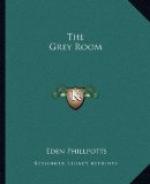“Not on my account, Uncle Walter,” said Henry Lennox. “I have no more respect for them than yourself. They are hopeless as art.”
“No, no one must restore them. The art is I believe very bad, as you say, but they were most worthy people, and this is the sole memorial remaining of them.”
“Do let us see the room, governor,” urged Tom May. “Mary showed it to me the first time I came here, and I thought it about the jolliest spot in the house.”
“So it is, Tom,” said Henry. “Mary says it should be called the Rose Room, not the grey one.”
“All who care to do so can see it,” answered Sir Walter, rising. “We will look in on our way to bed. Get the key from my key-cabinet in the study, Henry. It’s labelled ‘Grey Room.’”
CHAPTER II
AN EXPERIMENT
Ernest Travers, Felix Fayre-Michell, Tom May, and Colonel Vane followed Sir Walter upstairs to a great corridor, which ran the length of the main front, and upon which opened a dozen bedrooms and dressing-rooms. They proceeded to the eastern extremity. It was lighted throughout, and now their leader took off an electric bulb from a sconce on the wall outside the room they had come to visit.
“There is none in there,” he explained, “though the light was installed in the Grey Room as elsewhere when I started my own plant twenty years ago. My father never would have it. He disliked it exceedingly, and believed it aged the eyes.”
Henry arrived with the key. The door was unlocked, and the light established. The party entered a large and lofty chamber with ceiling of elaborate plaster work and silver-grey walls, the paper on which was somewhat tarnished. A pattern of dim, pink roses as large as cabbages ran riot over it. A great oriel window looked east, while a smaller one opened upon the south. Round the curve of the oriel ran a cushioned seat eighteen inches above the ground, while on the western side of the room, set in the internal wall, was a modern fireplace with a white Adams mantel above it. Some old, carved chairs stood round the walls, and in one corner, stacked together, lay half a dozen old oil portraits, grimy and faded. They called for the restorer, but were doubtfully worth his labors. Two large chests of drawers, with rounded bellies, and a very beautiful washing-stand also occupied places round the room, and against the inner wall rose a single, fourposter bed of Spanish chestnut, also carved. A grey, self-colored carpet covered the floor, and on one of the chests stood a miniature bronze copy of the Faun of Praxiteles.
The apartment was bright and cheerful of aspect. Nothing gloomy or depressing marked it, nor a suggestion of the sinister.
“Could one wish for a more amiable looking room?” asked Fayre-Michell.
They gazed round them, and Ernest Travers expressed admiration at the old furniture.




